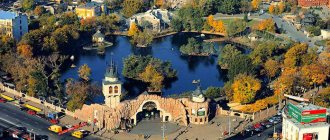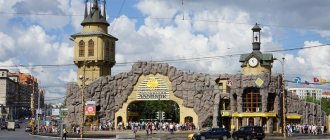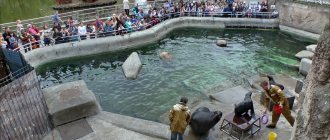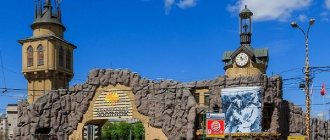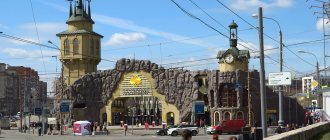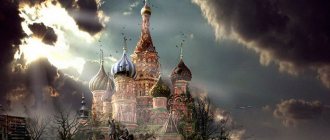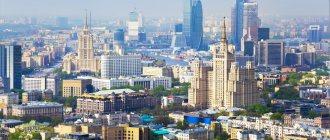The pride of the capital of Russia is the Moscow Zoo. Every morning this wonderful place opens its gates and happily welcomes new visitors. Here you can always hear children's laughter and exclamations of surprise, the voices of exotic animals and birds. The Moscow Zoo is a place of joy and fun, a corner of wonderful nature and an incredible atmosphere. It is one of the oldest zoos in Europe. In Russia, it ranks fourth in area, right after the zoos of Yaroslavl, Rostov-on-Don and Novosibirsk.
Birds of Prey Rock
The Birds of Prey Rock at the Moscow Zoo is a unique exhibition built around an artificial mountain with grottoes and ledges. Several enclosures, forming an irregularly shaped dome around the rock, contain representatives of large species of birds of prey: Steller's sea eagle, Andean condor, black vulture and griffon vulture.
Birds of Prey Rock can be recognized by its spectacular dome made of metal mesh on arched supports, which rises above the old zoo grounds.
The artificial rock imitates the natural habitat of birds: it has balconies and ledges, and houses bird houses. The airspace of the enclosures is intended for flight, although its capabilities are, of course, limited.
There are technical rooms inside the rock.
Terrarium
The Moscow Zoo Terrarium is a fairly large pavilion that displays a large collection of large reptiles: crocodiles, snakes, and turtles.
The largest specimens usually attract the greatest interest from visitors: the reticulated python (a large snake that can reach a maximum length of 12 meters), the Madagascar boa constrictor, the Mississippi alligator, the snout-snouted crocodile and the gharial crocodile. The Mississippi alligator named Saturn deserves special attention - he is more than 80 years old, during his life he managed to live in the Berlin (before the Second World War) and London (where he was delivered as a trophy) zoos, and in 1946 he was donated to the Moscow Zoo, where he still lives.
The Terrarium has earned particular love from young zoo visitors: children look at the reptiles with interest and animatedly argue whether the crocodiles on display are alive or just stuffed animals. The fact is that crocodiles lead a sedentary lifestyle, and you can spend a long time watching them and not notice a single movement.
In the outdoor enclosures of the Terrarium you can see giant land turtles.
Secretive Pallas's Cats
For many years, the main symbol of the Moscow Zoo was the Pallas's cat. The charismatic wild cat graced the institution's emblem from 1987 to 2014. But the history of keeping this animal in the zoo is much longer. According to archival documents, the first Pallas' cats were brought here back in 1949. Since 1975, Pallas' cats began to breed regularly, and since then more than 140 cubs have been born. Today, the Moscow Zoo is the undisputed leader in the number of baby cats born in captivity.
Pallas' cats are quite rare in the wild; their numbers, unfortunately, continue to decline rapidly. In addition, Pallas' cats are extremely secretive and distrustful animals; they are very skillful at hiding. Because of this, even in areas with large numbers of Pallas's cats, it can be difficult to spot. For the same reason, zoo guests rarely manage to catch Pallas’ cats in the enclosure: the secretive cats prefer to get out when it gets dark, and during the day they lie down in their houses.
The Moscow Zoo is not the only organization that has chosen the Pallas's cat as its symbol. The image of this furry predator can be seen on stamps and coins of some countries where it lives (Tajikistan, Azerbaijan, Mongolia, Kyrgyzstan). Despite the fact that the Pallas's cat is not found either in Europe or in Africa, it was included in the issues of UN and Benin stamps dedicated to rare species of animals.
Photo: courtesy of the Moscow Zoo press service
Primates
The Primates Pavilion, also known among visitors as the Monkey House, is one of the largest pavilions at the Moscow Zoo, housing about 30 species of primates.
In the exhibition you can see both very small monkeys - marmosets, tamarins and others, as well as larger ones. The greatest interest among visitors is caused by great apes: orangutans, gibbons and gorillas, to which an entire wing of the pavilion is allocated. In the basement of the pavilion, where twilight reigns during the day, you can see the nocturnal prosimians loris and galagos.
Among other things, information stands contain a large amount of information about our closest relatives.
Night world
The Night World Pavilion, located on the old zoo grounds near the Tree of Fairy Tales sculpture, is not very large, but has a very interesting exhibition that is especially attractive to children.
It is designed in the form of a dark, semi-underground cave where nocturnal animals are kept. Day and night in the pavilion have switched places: when there are visitors, it is dark, but when the zoo closes, fluorescent lamps are turned on here. In the enclosures you can see acacia rats, African dormouse, spiny mice, chinchillas and degus, house possums, gerbils and hedgehogs, as well as bats.
Most of the inhabitants of the “Night World” are small and inconspicuous, so it can be difficult to see them behind the glass, and visitors linger for a long time near the enclosures, trying to figure out where the animal is hiding.
Where can your child play and exercise?
It is worth noting that the park has many play areas for children.
In addition, for children there is a club for young biologists, various lectures, art studios and much more, which will help the child better understand the world of the world's diverse fauna (you can also find more detailed information on the official website).
Those who come here with infants will be able to change and feed the child in a special room located to the left of the main entrance.
Arachnolandia
The Arachnolandia pavilion, located on the old territory of the Moscow Zoo, presents visitors with an extensive collection of arthropods - not only spiders, as the name suggests, but also scorpions, centipedes, phrynes and mantises.
Arachnolandia presents about 60 species of arthropods: the exhibition is one of the largest in Europe! In the terrariums you can see karakurts, tarantula spiders, goliath spiders (the largest species of spiders in the world), house spiders and harvestmen, wasp-shaped argiope, jumping spiders, giant and imperial scorpions, phrynes, centipedes, mantises and other curious inhabitants.
Visiting the pavilion is possible accompanied by a guide and is carried out in sessions.
Education and zootherapy
The excursion program of the Moscow Zoo is very extensive! So that little visitors can get to know the animals better, they are given various excursions around the zoo and individual pavilions. Children's groups and individual families can take part in thematic excursions and get acquainted with the animals of individual regions. On weekends, the Old Territory offers an "Equator Walk" tour, during which children are taken to see elephants, giraffes, tapirs, red pandas and colorful tropical birds.
On Saturdays, the zoo hosts a Children's Lecture. Hour-long classes for children aged 6-12 years are conducted by professional zoologists, oceanologists and ecologists. During lectures, they talk about the peculiarities of keeping animals in captivity, as well as about animals and birds that live in the capital and the nearest suburbs of Moscow.
Polar bear
Biology lessons are taught at the zoo for schoolchildren. Children from 5 to 12 years old are invited to learn how to draw, take high-quality photographs, create cartoons and sculpt animals in the Art-Zebra studio. Schoolchildren from 7 to 11 years old are welcome in the biological circle “Manulyata”.
Young visitors with health problems are also not ignored. Zoo staff conduct zootherapy classes for them. Children easily relax from communicating with animals and get a lot of positive emotions. Unusual meetings are organized in the zoo itself, in orphanages, boarding schools and at home.
White-tailed Wildebeest
Animals of Africa
“Animals of Africa” (“African glade”) is practically a corner of the African savannah, where you can see several species of large African animals that feed in different plant layers and do not compete with each other.
In the largest enclosure, the reticulated giraffe and Grevy's zebras peacefully coexist, and in the neighboring ones you can see the sable antelope, the pygmy dik-dik antelope, meerkats and the pygmy hippopotamus. In the summer they walk in open enclosures, but in the cold season they move to a warm pavilion.
The local “star” was the dwarf hippopotamus Ksyusha, whose touching appearance was very much loved by visitors to the Moscow Zoo.
Her Majesty's Pelicans
The tradition of giving pink pelicans to the English royal family dates back to Tsar Alexei Mikhailovich. Russian boyars, going to England to establish trade relations, brought there the most valuable things: sable furs, luxury goods and, oddly enough, pink pelicans. These birds were not found in Foggy Albion, therefore, when the Russian ambassadors presented King James I with two outlandish individuals, he was quite amazed. The pelicans were settled in the best park in London, and they, giving birth, lived there for three hundred years. However, the pelican family gradually dried up, and the British, who fell in love with the beautiful birds, asked to give them a couple more individuals.
Thus, the long-standing tradition was revived already in the 20th century. In 1978, the British Ambassador to the USSR was presented with two pelicans from the Moscow Zoo as a sign of friendship and fruitful cooperation between the countries. Today their descendants can be found walking around the lawns of St. James's Palace.
Photo: courtesy of the Moscow Zoo press service
Turya Gorka
Turya Gorka is another artificial mountain, similar to the Rock of Birds of Prey, but with fundamentally different inhabitants: mountain ungulates live here.
Gradually narrowing towards the top, the hill is replete with ledges and caves, among which you can see marking goats and Dagestan aurochs. It is especially interesting to watch the males: when they clash their horns, they often engage in ritual fights, and on steep slopes this looks truly spectacular.
Children's Zoo
The Children's Zoo is a special part of the Moscow Zoo, located on a new territory near the Garden Ring. It is designed to introduce the youngest visitors to different types of domestic animals: here you can see cows, rams, rabbits, roosters, chickens, geese and pigeons of various breeds bred by man.
There are also playgrounds here.
At the moment, the Children's Zoo is completely closed for reconstruction (until the end of 2021).
Map of the park and who can be seen here
The map, for the convenience of visitors, is printed on the back of the entrance ticket.
In addition, throughout the entire space there are information boards with an enlarged map and signs on how to get to a particular enclosure or pavilion.
As we indicated above, here you can see about 5 thousand animals, birds and reptiles.
History of the Moscow Zoo
The Moscow Zoo is one of the oldest zoos in Europe. It was organized by the Russian Imperial Society for the Acclimatization of Animals and Plants and opened on February 12, 1864 (January 31, old style). One of the main initiators and inspirer of its creation was the famous zoologist and popularizer of natural sciences Anatoly Bogdanov, who saw the created zoo as an “open-air museum.”
The zoo did not have full government support, and therefore soon found itself in a dire financial situation: income from entrance fees and donations was not enough to cover the costs of maintaining the animals, and the Acclimatization Society was forced to sell many of the animals abroad. As a result, the exhibition became poorer and attendance fell even lower. Trying to improve his budget, the Society rented out the zoo to private entrepreneurs, but this did not produce tangible results, and he remained deeply in debt. In 1905-1907, the zoo found itself at the center of revolutionary battles and suffered significantly: the recently built Aquarium was completely destroyed, wooden pavilions and buildings were burned, and many animals died.
In 1919, the Moscow Zoological Garden was nationalized, and this became a turning point in its history: the city authorities began to allocate significant funds for the maintenance and replenishment of the animal collection. In 1924, for the development of the zoo, a new territory was added to it, expanding it to the Garden Ring; soon, according to the design of the architect Karl Gippius, artificial hills were built on it: “Island of Animals” and “Turya Hill”, as well as a monkey bar and other new pavilions. The annexation of a new territory and a change in the principles of exhibiting animals led to the renaming of the zoo into a zoo. At the same time, a research department was created at the Moscow Zoo and a Club of Young Biologists was organized. Subsequently, the territory of the Moscow Zoo was repeatedly reconstructed and updated.
During the Great Patriotic War, the zoo was bombed, which caused significant damage to it. Some of the animals were evacuated to the Sverdlovsk Zoo, the new territory was closed, but the old one continued to work and remained open to the public even during the most difficult years of the war.
After the end of the war, the Moscow Zoo was restored and flourished. In 1990-1997, its territory was reconstructed and updated; the Main Entrance and a pedestrian bridge between the old and new territories, which have survived to this day, were built on it, as well as new exhibitions and pavilions, including the “Rock of Birds of Prey”, “Polar” peace" and others.
Who lives in the zoo
At the moment, the zoo’s collection includes 1132 species of animals, the number of individuals is more than 5000! Moscow Zoo is the main zoo in Russia. More than 3 million people visit it every year and it is one of the ten most visited zoos in the world. It is also the headquarters of the Euro-Asian Association of Zoos and Aquariums. Active research activities are carried out within its walls, it takes part in projects for the maintenance and study of animals, and breeding of rare species in artificially created conditions is practiced here. The zoo's vast collection includes 174 species of mammals, 302 species of birds, 246 species of reptiles, 48 species of amphibians, 148 species of fish and 214 species of invertebrates.
Sable, flying squirrel, wolverine, steppe cat, armadillo, beaver, otter, llama, tapir, capybara, skunk, muskox, antelope, camel, elephant, giraffe, possum, lion, tiger, cheetah, puma, jaguar, lynx, hyena and more dozens of other species of animals live in the Moscow zoo complex. It’s impossible to list them all. There are also many feathered fauna here: swan, mandarin duck, goose, duck, heron, cockatoo, ibis, flamingo, barn owl and others. A huge number of reptiles, fish, amphibians and invertebrates have found refuge in the capital's zoo.
Demonstration feedings
In addition to viewing the main exhibition of animals, zoo visitors can see demonstration feedings.
Demonstration feedings are an opportunity to become more familiar with the habits of animals, because it is during feedings (the hours of which animals remember well) that they are most active. In addition, for some of them feeding is associated with play.
At the Moscow Zoo you can see demonstration feedings of jackals, two-toed sloths, jungle cats, otters, beavers and martens, mongooses, northern fur seals, gray seals, pink pelicans, as well as amphibians, which are held on a scheduled basis in the summer.
Leisure
Visitors are never bored at the Moscow Zoo. Both children and adults will find activities here to their liking. In this excellent place you can see different ponds, differing in size and inhabitants, admire the proud and graceful big cats, observe the habits of predatory animals of the canine family - wolves, jackals, foxes, raccoons, see the dazzling polar world of polar bears and penguins. It is impossible to pass by the enclosure with giraffes and the huge elephant barn without gasping in surprise. The zoo also features a fun Monkey House. There are a huge number of species of these cute animals. Visitors will also enjoy a fascinating immersion into the world of arachnids and cold-blooded animals in the terrarium.
Animals at the Moscow Zoo live in comfortable enclosures, more like well-appointed mini-hotels than cages. Here they are cared for and cherished, and they, in turn, delight the guests of the zoo. An unimaginable number of artiodactyls and exotic animals were brought to the Moscow Zoo from the most remote corners of the planet for the pleasure, fun and educational leisure of wildlife lovers.
For small children there is organized horse and pony rides, and a small amusement park has been created. There is a cafe on the territory of the zoo where you can relax, eat, and quench your thirst while walking! The territory of the zoo is green; in spring and summer, bright flowers delight the eye.
Opening hours, how to get there
The Moscow Zoo is open to visitors all year round and operates daily. It is best to visit it in the summer, when animals live in outdoor enclosures; In winter, most of them are transferred to warm pavilions (and some hibernate), and the exhibition available to visitors is noticeably reduced.
Opening hours: from 7:30 to 20:00 in summer, from 09:00 to 17:00 in winter. Entrance to the zoo closes one hour before closing.
Cost of visiting: 500 rubles (full ticket, adults); for a number of preferential categories - free of charge. Entrance to some pavilions and exhibitions (Exotarium and others) is paid separately.
The official website of the Moscow Zoo: moscowzoo.ru - on it you can check the work schedule, ticket prices, as well as the schedule of demonstration feedings on a specific selected day. Here you can buy tickets online or book a tour.
The Moscow Zoo is located at Bolshaya Gruzinskaya Street, 1. You can get to it on foot from the Barrikadnaya on the Tagansko-Krasnopresnenskaya line and the Krasnopresnenskaya Koltsevaya metro station.
Entertainment
You can buy soft drinks, ice cream, baked goods, snacks and candy at various places in the zoo. In addition, the kiosks sell fun themed souvenirs and toys.
One of the popular activities that Moscow has to offer for children is pony riding at the zoo. The circle around which children travel in sleighs and carriages has existed for many years. Some Muscovite families keep old photos of children of different generations riding ponies.
The zoo organizes children's parties and birthdays all year round. Children and schoolchildren have the opportunity to have fun with friends and take part in interesting quests, educational programs and attractions.
Bengal Tiger (White Variation)
Before going to the zoo, you should look at its website and see the feeding schedule for large animals. It is always interesting for children to see how animals get food and communicate with their keepers.
